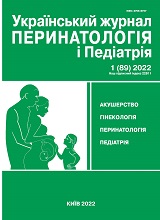Reproductive losses in Ukraine: current situation
DOI:
https://doi.org/10.15574/PP.2022.89.5Keywords:
reproductive losses, forced abortions, stillbirth, infant mortalityAbstract
During the transformation of society, accompanied not only by socio-economic decline, but also by unfavorable indicators of population reproduction, the issue of reducing reproductive losses and maintaining the viability of offspring at all stages of ontogenesis.
Purpose - to investigate the condition and dynamics of the main components of reproductive losses in Ukraine.
Materials and methods. A comprehensive retrospective analysis and assessment of the dynamics of reproductive losses and their main components in Ukraine for the period 2000-2021 according to the State Statistics Service of Ukraine and the State Institution «Center for Medical Statistics of the Ministry of Health of Ukraine». Methods of system approach, bibliographic, structural-logical, epidemiological analysis of statistical data processing, graphic image are applied.
Results. A continuous study of the dynamics of reproductive loss at the population level showed a positive trend in the number of total reproductive losses - 86.1 per 1,000 live births in 2000 and 57.0‰ in 2021, OR with 95% CI 0.63 (0.62-0.65), p<0.0001, in violation of the trend of gradual decline of this indicator by its growth in 2005 up to 72.1‰, in connection with the preparation of perinatal facilities for the transition to the WHO criteria for perinatal period, live births and stillbirths. The downward trend was characteristic of prenatal losses - spontaneous (spontaneous) abortions, and medical legal abortions in the period from 12 to 22 weeks of pregnancy, the number of which decreased from 68.8 per 1,000 live births in 2000 to 43.2‰ in 2021, OR with 95% CI 0.63 (0.59-0.67), p<0.0001, and deaths in the first year of life - from 11.9‰ to 7.2‰, respectively, OR with 95% CI 0.7 (0.66-0.74), p<0.0001. At the same time, the stillbirth rate tended to increase - from 5.4‰ to 6.6‰, OR with 95% CI 1.23 (0.9-1,3), p<0.0001, against the background of a steady increase in the share of antenatal fetal death from 85.3% in the structure of stillbirth in 2001 up to 94.5% in 2021.
It is established that in Ukraine in the structure of registered total reproductive losses during the entire observation period prenatal losses up to 22 weeks of gestation amounted to a total of 74.1%, of which spontaneous abortions 57.9%, medical legal abortions from 12 to 22 weeks 16.2% of pregnancies and 25.9% of feto-infantile losses, of which 15.7% died in the first year of life and 10.2% were stillborn. In the dynamics of the XXI century, the share of medical legal abortions in the period from 12 to 22 weeks of pregnancy decreased 3 times and those who died in the first year of life by 7.3%. The trend to increase the proportion was stillborn by 87.1% and spontaneous abortions by 29.6%.
Conclusions. The situation with the state and dynamics of the main components of reproductive losses in Ukraine in the XXI makes it appropriate to further develop the family planning service, the formation of a comprehensive medical and social program to correct reproductive behavior and improve women’s reproductive health.
No conflict of interests was declared by the authors.
References
Aliieva TDK. (2021). Medyko-sotsialne obgruntuvannia vprovadzhennia optymizovanoi modeli profilaktyky henetychno obumovlenykh reproduktyvnykh vtrat. Ukrainskyi zhurnal medytsyny, biolohii ta sportu. 6; 1 (29): 213-221.
Harashchenko TM. (2011). Reproduktyvni vtraty vnaslidok mertvonarodzhen v Ukraini: demohrafichnyi aspekt. Demohrafiia ta sotsialna ekonomika. 2 (16): 156-165.
Kalynychenko DO. (2019). Kilkisna otsinka reproduktyvnoho potentsialu zhinok rannoho fertylnoho viku. Dovkillia ta zdorov’ia. 3: 11-16.
Lekhan VM, Hinzburh VH. (2012). Perynatalna smertnist v Ukraini: dosiahnennia ta problemy. Ukraina. Zdorovia natsii. 1 (21): 5-25. URL: http://nbuv.gov.ua/UJRN/Uzn_2012_1_4.
Libanova EM ta in. (2006). Kompleksnyi demohrafichnyi prohnoz Ukrainy na period do 2050 r. Za red. chl.-kor. NANU, d.e.n., prof. E.M. Libanovoi. K.: Ukrainskyi tsentr sotsialnykh reform: 138.
Lytvyn NV, Henyk NI. (2017). Otsinka prychyn rannikh vtrat vahitnosti u zhinok iz bezpliddiam, vkliuchenykh u prohramu dopomizhnykh reproduktyvnykh tekhnolohii. Aktualni pytannia pediatrii, akusherstva ta hinekolohii. 1: 84-89.
Martynova LB. (2016). Suchasnyi stan vidtvorennia sotsialno-demohrafichnoho potentsialu v konteksti realizatsii yevrointehratsiinykh prahnen Ukrainy. Ekonomika rozvytku. 80 (4): 23-33.
Marushko RV, Dudina ОО. (2020). Modern aspects of perinatal mortality in Ukraine. Ukrainian Journal of Perinatology and Pediatrics. 2 (82): 76-85. https://doi.org/10.15574/PP.2020.82.76.
Starodubov VY, Sukhanova LP, Sichenkov YuH. (2012). Reproduktyvnie potery kak medyko-sotsyalnaia problema demohrafycheskoho razvytyia Rossyy. Sotsyalnie aspekti zdorovia naselenyia. URL: http://vestnik.mednet.ru/content/view/367/30/lang,ru/.
Tsvihun IA. (2013). Demohrafichna bezpeka Ukrainy ta napriamy yii rehuliuvannia. Monohrafiia. Kam’ianets-Podilskyi. Vydavets PP Zvoleiko D.H.: 400.
Downloads
Published
Issue
Section
License
Copyright (c) 2022 Ukrainian Journal of Perinatology and Pediatrics

This work is licensed under a Creative Commons Attribution-NonCommercial 4.0 International License.
The policy of the Journal “Ukrainian Journal of Perinatology and Pediatrics” is compatible with the vast majority of funders' of open access and self-archiving policies. The journal provides immediate open access route being convinced that everyone – not only scientists - can benefit from research results, and publishes articles exclusively under open access distribution, with a Creative Commons Attribution-Noncommercial 4.0 international license(СС BY-NC).
Authors transfer the copyright to the Journal “MODERN PEDIATRICS. UKRAINE” when the manuscript is accepted for publication. Authors declare that this manuscript has not been published nor is under simultaneous consideration for publication elsewhere. After publication, the articles become freely available on-line to the public.
Readers have the right to use, distribute, and reproduce articles in any medium, provided the articles and the journal are properly cited.
The use of published materials for commercial purposes is strongly prohibited.

